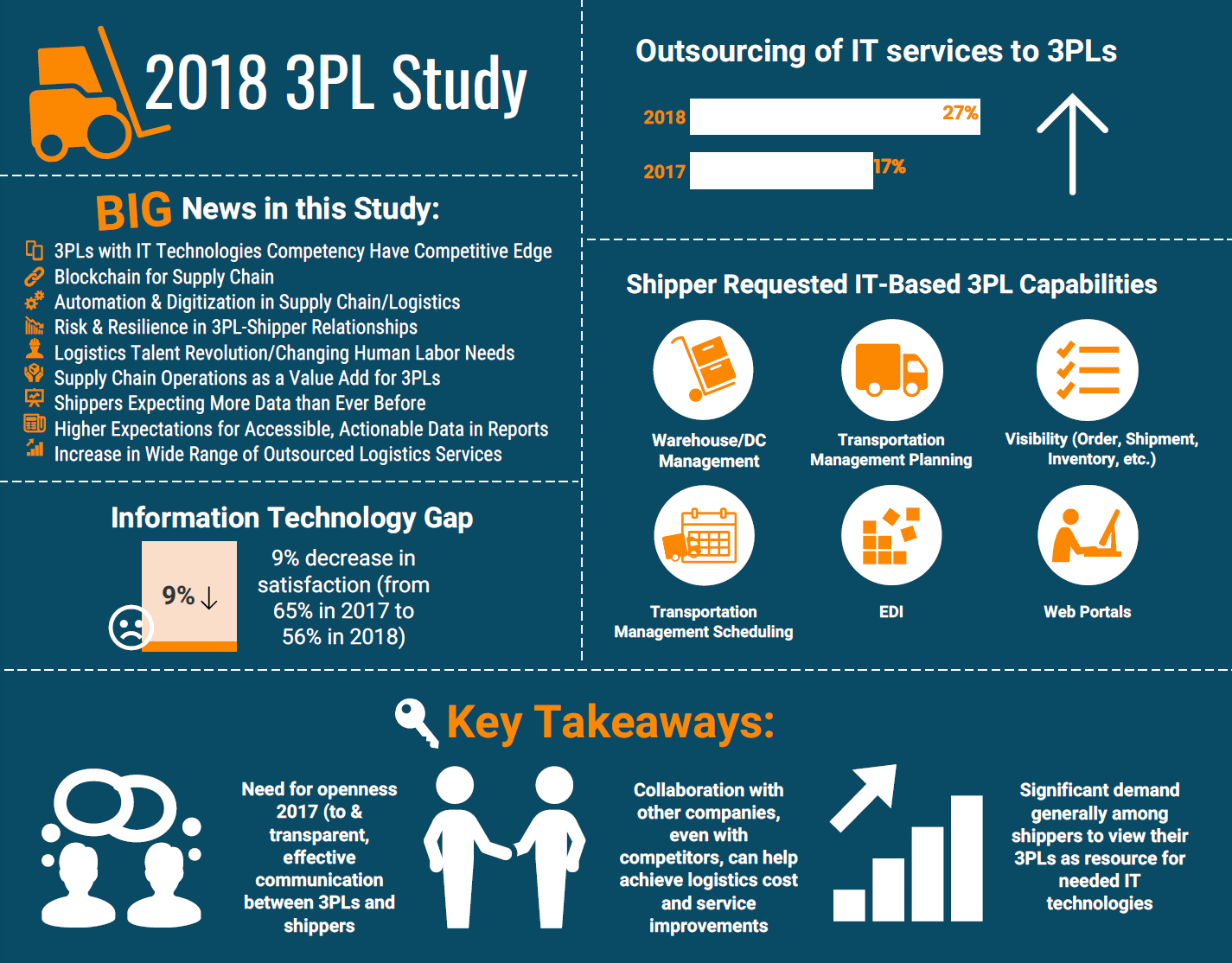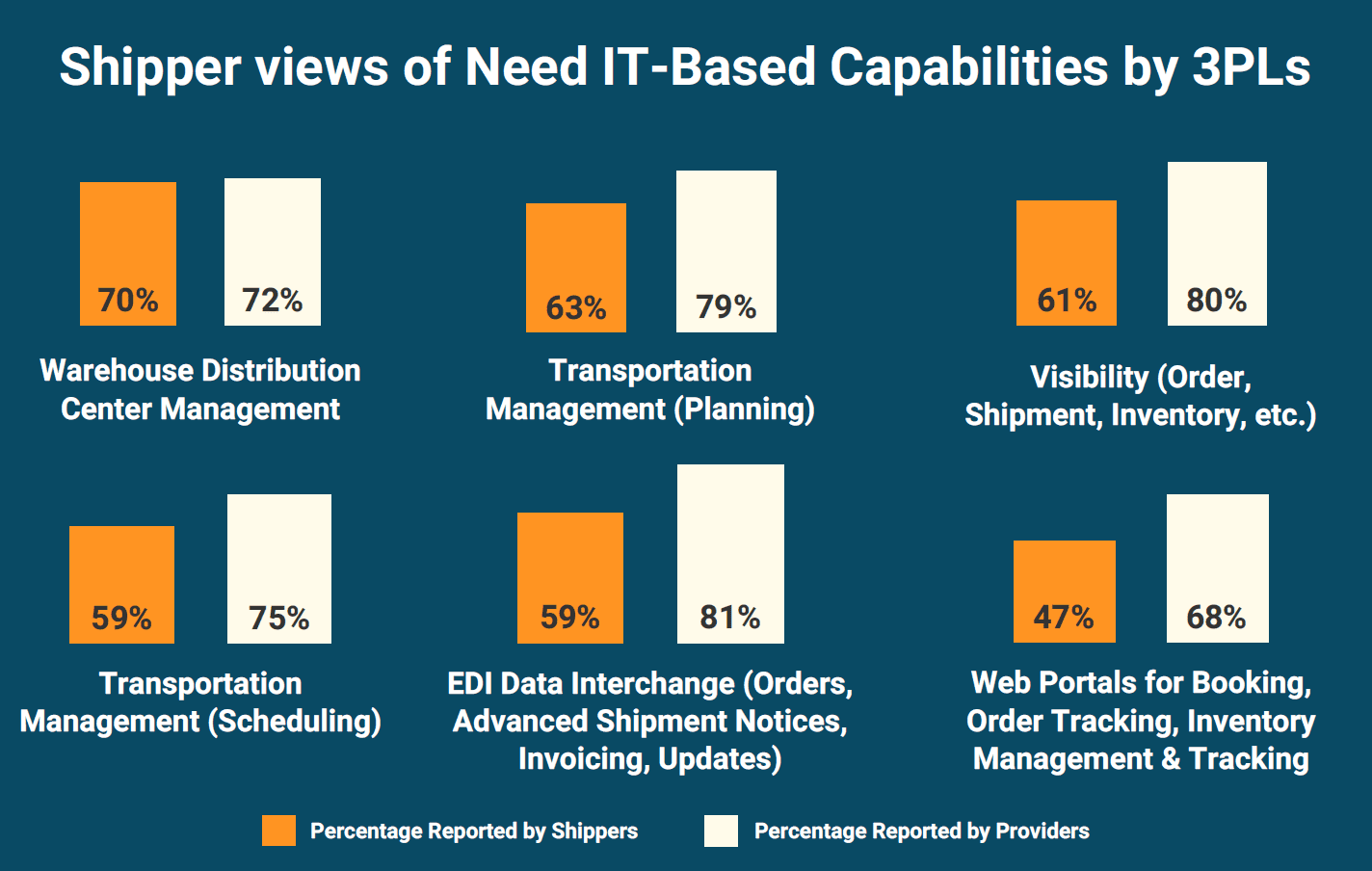2018 3PL Study Recap: 3PL-Shipper Collaboration & 3PL IT
2018 3PL Study Recap: 3PL-Shipper Relationships & 3PL IT CapabilitiesIntroduction
As the speed of supply chain and logistics operations advances to service increasing consumer demand, there is a greater need for
True partnerships between shippers and their 3PLs are producing innovative solutions, reductions in logistics costs and better results for shippers.
More companies are outsourcing IT services to 3PLs as compared to past years, giving 3PLs who adopt
The 3PL-Shipper Relationship Has Evolved into Collaborative Partnerships
For
The increased availability of data has helped to provide critical information for decision making while also establishing higher shipper expectations. Powered by ever faster technologies, the supply chain is struggling to adapt to changing demand patterns, more competitors, changing business models, new regulations, labor shortages and the rapid expansion of e-commerce and consumer demands. To put it mildly, it is certainly quite challenging for all concerned.
In years past, speed was less of a factor and supply chain process was viewed as a function for 3PL partners, rather than mission-critical operations that could provide a competitive edge for
To improve supply chain logistics operations, it is critical that all parties have access to immense amounts of data, as close to
Shippers and 3PL logistics providers that have recognized the nature of this problem have begun to form true partnerships rather than simple transactional relationships. While most shippers tend to outsource transactional activities, those who form partnerships with
In the 2018 3PL Study, a larger number of shippers reported that
As the retail industry continues to evolve and experience considerable disruption, technology is enabling consumers to make purchases and receive expedited delivery service, some in as little as the same day or even in one hour. Companies such as Amazon, grocers
Because more consumers are ordering online for delivery, package volume is up. This is altering distribution networks and expanding the need for last mile delivery and logistics capabilities to meet consumer expectations and help ensure cost savings. Actionable data, efficient supply chains
Many factors have increased the pressure on 3PL partners to perform, react quickly and nimbly scale up or down based upon demand. These factors include but are not limited to:
- The increased complexity of supply chains
- Shortened time periods in supply chain logistics operations and to react to changes
- Consumer demand for more convenience
- Streamlining of inventories by shippers and retailers
- Reduced product lifecycles in many industries
The 2018 3PL Study notes the continued evolution of the 3PL-shipper relationship and proficiency in operations. Today it is not enough to focus on core competencies such as handling inventory, processing orders and shipments and billing shippers accordingly.
Today shippers expect their 3PL partners to have access to and use more sophisticated technology platforms, handle pick and pack, provide supply chain visibility and even be
Improvements in proficiency and more sophisticated capabilities have evolved into more collaborative, less transactional relationships.
This has aided in enabling more streamlined, efficient operations within shippers’ supply chains and improved service levels. Perhaps because of this, there has been a greater focus on sustainability, philanthropy
To be able to react more quickly to changing consumer demands, retailers continue to try to reduce inventory in order to free up capital and enable more freedom in decision making. Because of the need for a top functioning supply chain in ensuring the effective operation of a just-in-time inventory system, the reliance on logistics providers for information visibility and services as well as for cost savings continues.
- Innovative new ways to enhance logistics effectiveness were contributed by 3PLs
- Using 3PLs contributed to an overall reduction in logistics cost
- Improvement in services to the ultimate customers was obtained by using 3PLs
In order to create the flexible, responsive supply chains needed to maintain the necessary competitive advantage, shippers and 3PLs have found new ways to collaborate rather than on simply moving goods from one point to another. Speed is essential. To have an effective supply chain logistics operation, there must be transparency and open communication between 3PLs and their customers. Gainsharing and collaboration have increased in use. This had helped to solidify relationships and create positive outcomes for both parties including cost savings.
3PL Adoption of IT Technologies
More 3PLs are providing data collection and analysis, advanced visibility and additional core services. This is enabling them to develop new ways to improve their customers’ supply chains.
At any point in the supply chain, decisions can be made to change the course of shipments.
Having
As in past years, shippers tend to outsource execution-oriented, transaction-based activities to third party logistics providers. Since the 3PL Study originated 16 years ago, it has studied the “IT Gap”, the difference between how shippers view information technologies to be essential elements of 3PL expertise and their level of satisfaction with their particular 3PLs’ IT capabilities. The percentage of shippers who perceive IT capabilities to be critical has remained at a consistently high level. Over time, the level of satisfaction with 3PL IT capabilities has increased nearly 30% since 2002. This year, however, the satisfaction level dropped 9%.
Is this because advances in technology have raised shipper expectations? Could it be that more sophisticated analytical capabilities are desired by shippers to keep their supply chain operations at a very high level? These are two ideas proposed. Only time will tell.
With the abundance of advanced and emerging technologies on the market today, perhaps supply chain businesses have new expectations or a feeling of “missing out” if their 3PL is not utilizing
Competencies in IT technologies, increased levels of IT services and greater expertise and use of advanced technology are becoming increasingly more desirable, even expected and provide a competitive advantage to 3PLs.
Summary
The 2018 3PL Study reports some notable information regarding 3PL IT capabilities and the nature of 3PL-Shipper relationships:
- Shippers continue to outsource transaction-based and execution-oriented activities to 3PL as compared to activities which tend to be more customer-facing, strategic or IT-intensive.
- The IT Gap widened this year, indicating a 9% lower level of satisfaction of shippers with their 3PLs’ IT capabilities
- Shippers have come to expect
real time visibility and a higher level of IT competency when it comes to their 3PLs - 3PLs that have embraced
cutting edge technologies, advanced analytics and reporting and are able to utilize technology to improve supply chain operations and cut costs have a competitive edge when it comes to winning new business - No longer do companies simply view supply chain logistics as a means to move goods or process inventory, orders and shipments. Now there is a greater awareness and need for flexibility and agility across the supply chain and the need for just-in-time operations to meet
ever changing consumer demand and expectations.
What Makes Datex Different?
1. Revolutionary low code/no code flexible workflow-driven warehouse management software
2. Most configurable, user-friendly WMS on the market today
3. End-to-end solution provider: software, hardware, EDI, and managed services
4. White Glove Concierge Service
5. Executive-level attention and oversight








